
bloggie thingie

send us an email
We currently have a full range of sizes in top quality Japanese iaito from 2.3 to 2.6 shaku, in half shaku sizes.
Lots of inventory which means we've got lots of Lauren's university tuition tied up in boxes around the house so feel free to use some of that Christmas Cash. That's the downside of having iaito here to ship to you immediately, it costs us a lot... not that I'm trying to guilt trip you or anything...
We have also ordered a range of sizes (up to 2.6, I'm checking once more about 2.65 or more) of shinken from China and I will let you know when they arrive. In the meantime we have one 2.4 shaku shinken left. This shipment is also going to cost a bundle so if you want to pre-order I will be more than happy to hear from you.
First installment is at: http://ejmas.com/tin/gorinsho/tinart_taylor_1201.html
If anyone wants to have the entire translation right now, I'm happy to provide it in PDF form at its current state (99% done) for $10. Just email me.
Since I try to make a living at this stuff I'm sure I can count on you guys not to create groups to purchase and re-copy it??
I just had a question about the difference between these two training tools and so I thought I'd provide my answer here for future reference.
Suburito training is generally to do the same techniques you would normally do with your bokuto or sword, but using a heavier or differently balanced tool in order to make the use of your regular weapon feel easier. It has a muscle building component but is mostly about making you feel the movements of the art in a different or more exaggerated way. It's a training directly aimed at the specifics of your art.
Tanren bo training on the other hand usually can't be used for the more subtle motions of your art. It is for training strength and for rehabilitation of injury. The movements must be careful, and very pure, not done off balance or off center. It's more an overall conditioning system that is applicable to just about any art, but must be used in addition to one's usual training rather than an adjunct to that training.
We've got some new items on the website for you to check out, a new shipment of top quality iaito, new cloth sword bags from Brenda, and two (count em) shinken at 2.4 shaku length. If you normally use a 2.45 it's often recommended to go a half down for your shinken.
Check it out from the front page http://sdksupplies.com/
I don't know if we're going to get the 2.6 ultralights now, the supplier seems to have gone silent... not an unusual situation when dealing with China actually, but I have been working with one of the 2.45 lengths since my shoulder and knee have blown and they're very easy on the body.
This one is perpetual, it's one of the main arguments I hear for practicing koryu. Almost inevitably it's brought up by those folks who are practicing a koryu on the edge of extinction, some local variant or even mainline school is down to four or five students and a Westerner starts to practice. Back home after many years they look for students and try to "keep the school alive" to preserve a part of Japan's heritage.
A noble goal, but one I've never had myself.
If, as one westerner, the last of his line, once said to me, the Japanese can't be bothered to keep this stuff alive, why should I worry about it. On the other hand, I'm sure there are three or four Europeans who would love to come to Canada and learn Ice Hurley and take it back to keep it alive to preserve a piece of Canadian culture. Or some Japanese fellow who would like to keep the eighteenth century Virginian "boxing" (kick and gouge wrestling... gouging out an eye was one way to win a bout) alive. http://jmanly.ejmas.com/articles/2001/jmanlyart_gorn_0401.htm
Bits and pieces of culture do sometimes stay around in a culture without any application to modern times, but these aren't a sure thing. If the modern culture has no use for them, they might stick for a few generations provided they have strong supporters, but they're doomed. One day a son isn't going to want to keep welding the parts back on the steam tractor his father treasured.
Now, there are some martial arts that are doing just fine thank you. Judo is a sport, lots of students there, so's Kendo. They're both fun and kids love them. Karate sure, same thing.
Adult oriented martial arts might include Aikido, koryu jujutsu (as opposed to the western AiKaJuDo mixtures which appeal strongly to kids who want to compete in the UFC) and any of the rest of the sword or staff arts. Kids may want to practice with swords, but the kata-based instruction of the old schools is just not fun and there's Kendo around the corner. What is it about the arts that mostly attract older folks? It's not the slam-bang action with the brittle crowd, no it's more about the self. Either the fantasy life of being a modern samurai (usually doesn't last), the noble (but ultimately doomed) effort to save Japanese medieval culture, or a seeking after self-improvement, be it mental or physical.
In my experience, the healthiest koryu schools in the west are those who go after the self-improvement crowd. They're also the ones who are smart about getting new students, which means those that have attached themselves to the kendo federation (to catch those kendo adults who have blown their achilles tendon) or share space with judo, aikido or karate clubs. The sword and stick koryu are great places to move when rough and tumble becomes tough and fumble.
Which brings us back to some of the "save the culture" folks who seem to think that the way to get students is by explaining frequently and in painful detail that their koryu has no connection whatsoever to kendo or the kendo federation. Quite aside from the frequency of their senior instructors having been in the kendo federation ("He was only there to keep the art alive, he hated what kendo did to his art") their description of their art is a negative one. They are explaining what it's not, rather than what it is.
You know, if their teacher could stomach the kendo federation in order to keep their art alive for another generation....
But the humiliation you say? The demands to change the koryu?
Doesn't happen. Any instructor who changes his koryu while in the kendo federation does so at his own choice, the federation has nothing to say about koryu. Membership implies doing 12 kata of iaido or jodo as the federation defines them. Considering some of the obscure arts have 60 or 70 kata, that's not a lot of extra effort.
But the higher level kendo grades require a koryu kata or two and if you don't do it like the kendo federation likes to see it you can't get 7 or 8 dan!
Are you there for students and the perpetuation of your koryu or are you there to get rank? And even regardless of that, you can't modify one or two of your koryu kata in order to please the federation judges? Are you the last teacher (and therefore the owner by default if not by license) or not? Who says you can't do two variations of a kata, one pure line and one federation friendly?
But the constant practice of kendo federation kata leaks over into the koryu!
How long have you been training? If it's that easy to contaminate your koryu, you need to ask how deeply you know your art and whether or not you can transmit a faithful copy under any circumstance.
There's damned few people interested in these obscure arts, why set yourself against the sizable numbers in the kendo federation in an attempt to, what, avoid contamination? Steal students?
Just had a quick tour around some of the forums in my bookmarks and I see lots of new names cropping up with esoteric koryu to offer us poor underserved westerners.
At one point I used to go hunting for information on these guys because I wanted to know what was out there, but as always, the youngsters are keeping tabs and calling out the fakes with gusto so everyone will be safe from the frauds.
Me, I find myself a bit less interested in either the supposedly superior arts, or the secret knowledge of the new guys on the block, and not at all interested in the frauds. What I find myself saying mostly about the whole lot of them is "I don't know you".
And I think that's it really, why should I concern myself with folks I don't know? I don't know the students or the teachers so it's outside my responsibility.
But I should be one of the gatekeepers because I've been around so long?
Hah! In 20 years of writing about the martial arts I've never had any indication that I saved one person from folly, with the possible exception of those who asked me face to face about this or that instructor.
These days I suspect my advice would simply be "I don't know that guy".
Now, before you figure that's a cop-out, please be aware that "I don't know that guy" has always been one of the most valuable pieces of advice to me from my seniors. Think about it.
http://www.sirc.ca/newsletters/mid-nov11/index.html
It occurs to me that by the time you're a nidan in iaido you pretty much know all there is to know about the technical aspects of swinging a sword, and you could easily hack an enemy badly enough to win a fight. After all how much is needed to cut anything with a sword? I cut my thumb a while ago on a free-falling blade, just touched it in mid air and it was down to the bone before the blade itself moved away from the thumb in free-fall.
So why the extra 20 or 30 years training for those who get to the top of the grading ladder? How much more can they really know?
Turns out it's a lot more, but much of that is in the minute movements of force through the body, the mental aspects of working at something repetitive for years, how to teach, and other such things.
There are many people out there who can ski over a bump, and a very few who can do a triple twist with a flip over that same bump. There are many people who can do math, and very few who are pushing the field forward.
It's the nature of being at the top of any profession that you specialize, you concentrate, you spend the years in to get incrementally smaller results with each year of training. It's these guys who should be at the top of the profession, they're the ones who know a lot about the little that is any profession and I would always prefer to learn from these experts.
Not all those who put in the years are equally skilled of course. One can stop at a certain level of training and simply coast for the rest of one's career, either teaching or simply not paying attention. Those at the very top should avoid that sort of thing as it will lead at best to a stagnant art, one that never gets any better.
On the other end of this thought is how much training anyone needs to "use" a martial art. I'd argue that it's not much. I teach women's self defence and we have a ten week course that has returned some success stories and no failures that I'm aware of. The course doesn't teach how to fight, it teaches how to survive using a range of techniques that are simple and effective, and it's taught in ten weeks.
Most folks train in the martial arts somewhere between the 30 years it takes to get to the top of the heap, and the ten weeks it takes to learn something useful. Each person has to decide when they've had too much training.
A quick note to tell you all that we now have a place where students can donate toward the spread of iaido and jodo, the Canadian Iaido and Jodo Fund.
You'll find it at the following websites: iaido-canada.com, jodo-canada.com, iaido-canada.ca or jodo-canada.ca. Don't bother checking them all out, they're the same website.
This is a non-affiliated fund, independant of anything other than being intended for use to promote iaido and jodo. For a couple of decades the senior iaido and jodo folks have been kicking in their own money to promote the arts, and they will continue to do so I'm sure, but some students had commented that this was a bit unfair since they had trouble contributing in the same way. While this isn't really true (iaido and jodo students have always paid a fair price for any seminars we've presented) we thought we'd make it possible for everyone to contribute.
As a result, the CIJF, and you can join at the website above.
Now, the secret reason for the fund... it's run by the 6dan iaido and 5dan jodo sensei. These are the folks who will be taking over from the current top sensei one day, and it's up to them to start using this fund (ie thinking about how to expand the arts beyond what us old guys have done). I for one am looking forward to their ideas.
Lest you think they're not active now, they have produced strategic plans for both iaido and jodo which will likely be calling on this fund for implementation.
Four new videos for you to check out this month, just in time for Christmas.
The first two are a set of Niten Ichiryu Tachi Seiho, VIDBBI 11a and 11b and they have been done for a while, I just noticed I haven't put them online for sale... no wonder nobody is buying them. At any rate, they outline the first set of Niten Ichiryu kenjutsu as we practice it at the Sei Do Kai. This set is long sword vs long sword and is fundamental to the study of the style.

The next video is VIDBBI 13 and is the Niten Ichiryu Nito Seiho, the two-sword set which is the third level of practice. I have yet to make the video for the second level, the kodachi seiho but I promise.

The final video is VIDBBI 14 and it's a new Tachi Uchi no Kurai which is now my third attempt to make an instructional video... and it won't be my last but it's at least up to date.
You'll know why it isn't the last video when you watch it, there's some extra futzing around and the very last technique is cut off during the instructional comments, but it's shown elsewhere and the whole video is quite useable so I'm putting it out there until I can get around to doing yet another attempt. That won't be for a while so don't hold your breath.
Go get them you kenjutsu-krazed budoka!
Yet another call for a kenjutsu dojo on the net. Where can I find a club that does kenjutsu?
Well good news, look for any club that does Japanese sword arts and you've found it folks. Kenjutsu translates from Japanese to "sword arts" so if you've found Japanese sword instruction you've found kenjutsu.
And yet, and yet, there are clubs out there teaching "Kenjutsu" and they're getting students. I suspect that if it were 1963 they'd be teaching "Karate" (hell some still teach "Karate" even if they have to call it Korean Karate for semi accuracy), in 1978 the same clubs would be teaching "Kung Fu" and in 1983 "Ninja". Today the big one is "MMA" which ought to be a dead givaway to anyone who expands that to Mixed Martial Arts.
I want to study Mixed Martial Arts. I want to study Sword Arts. I want to learn to play Cards.
It's either very simple to find... look for any club that teaches more than one martial art or any sword art at all, or it's really hard to find... after all how easy is it to find someone to teach you how to play "Cards".
There's folks that will teach you "Kenjutsu" and there's lots of students studying "Kenjutsu" so have at it. Look up "Kenjutsu" on google and pay your dues.
Iai-Kyu (Patrick Suen) http://sueniaidokyudo.blogspot.com/
Tensho (Micheal Suen) http://tenshoiaido.blogspot.com/
Tales of a Budo Bum (Jeff Broderick) http://jeffsbudoblog.blogspot.com/
Sword: http://search.japantimes.co.jp/cgi-bin/fa20110901a1.html
http://search.japantimes.co.jp/cgi-bin/fa20040707a1.html
Girls and swords: http://search.japantimes.co.jp/cgi-bin/fd20100307a2.html
Book Review, I'm reading this book now myself, may be spoilers: http://search.japantimes.co.jp/cgi-bin/fb20060521a1.html
Actually my sensei gave me a major spoiler on this one.
Tea and Alberta: http://search.japantimes.co.jp/cgi-bin/fl20110716a1.html
DT Suzuki and Quebec: http://search.japantimes.co.jp/cgi-bin/fl20061116a1.html
By now you're on the website, run a search and have fun. Let me know if I should read any of these, I haven't had a chance yet.
The more I do this stuff, the more it all comes together. I'm currently exploring the similarity of grip between what I'm getting taught these days in Zen Ken Ren iai, and what I was taught in Niten Ichiryu, all mixed with a good dollop of Go Rin no Sho.
Here's something to go think about: Beginners tend to put their thumbs on the top of the hilt, and we keep knocking them off of there. Next time you have your hands in the position where you can do this (put the thumb on the top) try moving your hands so that you put your index fingers on the top instead. Lay your left hand and index finger on the hilt, index pointing at the tip of the sword. Now just fold down the finger and place your right hand on in exactly the same way.
Pay attention that you don't move your grip around, and swing with no muscle involved... check out your hasuji, the angle of the blade as it cuts. Check out the stop at the end of the swing.
Pinch thumb and index fingers on either side of the hilt, make sure that you aren't "pulling the trigger" to stop the blade, just pinch in from the sides.
Update:
We've tried these a few times now, and the verdict is that they are darned useful for things other than injury. There are sensei out there that want us big-armed westerners to use really light blades in order to learn some subtlety, and we usually end up using saya bokuto with very thin wooden blades. These ultralights are a step beyond those with a blade that will whip if your grip is wrong. Swing them properly and they are like a rock, make a mistake and you know it immediately. I like these things a lot.
Wow, finally got a shipment yesterday of our ultralight aluminum iaito, so we can now supply them in sizes from 2.35 to 2.45 shaku. (I'll cut them down myself.) A 2.45 will be photographed and put on the site soon but for now suffice to say that it is like a feather (570g to be exact, out of the saya). These are iaito for use for those who are injured, have rsi, or just can't handle a full weight iaito. I'll be getting one for myself in the next batch which will be going to 2.6 shaku.
Introductory prices on the 2.45 and under will be $230 plus shipping and taxes which will put them into the ultra-cheap category as well.
We'll be putting one through its paces tonight at class just to make sure all is good but the prototype for these is now in Japan with a hanshi who has trouble with his shoulder so I don't anticipate any problems or complaints about them.
If you're interested, just remember these are specialist tools for training, they are not intended to replace a proper iaito of correct weight and stiffness. They might be tempting for beginners due to the price but I doubt they will stand a lot of nonsense. They were created with maximum lightness in mind and it remains to be seen how much strength they have in them. A higher dan will have no problems but careless beginners might.
Right, 119 new one of a kind items now on sale.
Enjoy
Got about half (around 60) of the updates done on the one of a kind page for bokuto. There are some laminated musashi suburito there. Musashi suburito are lighter than normal suburito but longer so they work on leverage rather than weight. An interesting tool for training.
Got some regular suburito on there too.
I've also got a boar spear on there for anyone who wants to emulate Morihei Ueshiba's boar spear kata as seen in an old film circulating on the net.
This stuff is BOGR (buy one get a rebate on one.. or two.. or three of $20 each) Mention the BOGR sale which continues until September.
Missing are the SDK bokuto (no shoulder for tsuba), some war clubs, tanren bo and some tanto which I may or may not photograph.
Enjoy: http://sdksupplies.com/cat_bokuto_singles.html
It's unfortunate that I had to go to the second Google page to find the originator of that quote, the first page and a bit was devoted to some book on teaching. I didn't check it out, I'm sure it would only make me mad.
Look it up yourself, it's a command to practice hard, as if you are about to be run over by a bus five minutes from now. It is a command to urgency because if you don't practice this way you will never achieve enlightenment.
But can you live this way?
I speak from a place of having lived my life for the last thirty years as if I was going to die tomorrow. I have had episodes of blinding illumination, I have been spread throughout the universe, at one with the entirety of creation. I have felt the stars pulsing and the weight of the seas upon the bottom of the ocean.
But I also have atrial fibrillation and a very very low tolerance for self-delusion, hypocrisy and others who waste their lives putting things off. I drink too much so that I can get to sleep at night.
In other words, I've lost a sense of balance. You see, I don't meditate any more, I'm not in a monastary, I have no inka, no proof of achievement, no infrastructure which would set me up as a teacher who could indulge his irritation at the wasted time of 90 percent of the population as they go about their dull, blind lives. I have to live in those lives.
So, while watching Inspector Lynley (no I can't watch Survivor Bora Bora or Paris Hilton's farm adventures) I heard him state "there's always tomorrow".
There is, you know. Tomorrow. There is always tomorrow. If you die tonight (maybe from a meteor hit on your house) unenlightened, without having accomplished your great goal in life, without having apologized to your father for the hurtful thing you said when you were 15, it doesn't matter. You're dead and that's the end of it. You don't get to float around as a ghost or in some sort of afterlife regretting what you didn't do for all eternity. You're worm food.
Accept this and then embrace the sure knowledge that "there's always tomorrow". Because there is, ALWAYS tomorrow. This is life, there can be no other way to look at it. The alternative is oblivion, not an eternity of regret.
You are free to live forever, there is always tomorrow.
To live as if there is a great goal that you must achieve, to live as if your hair is on fire is a tool. A means to an end. The understanding that you are the dust of stars, that there is, quite possibly, no other form of life in the entire universe that is conscious of it's own existance, or the existance of the Universe. To know that we will never, ever know of such another life form if there is such a thing, is not something that you need to know in your bones. The fact that it doesn't matter if we are alone, that we can't be alone since we can't be apart from the very fabric of the entire universe, and that we can know this first hand, is also not something that you need to understand.
Enlightenment is a choice, if you want it, set a match to your hair and start working, but be aware that at the end, you must still chop wood and draw water, you still have to live in the world that you live in now. Nothing changes, you only see things in a grumpier way as you watch people live as if they will live forever.
As if there is always tomorrow.
As if their hair is actually not on fire.
But you live knowing that it is.
Many years ago... just a couple years after the world wide web started, we put our email list of iaido contacts onto a listserv through the University of Guelph and called it iaido-L
We had over 1500 folks on the list and they included all the top folks on the net at that time, as well as the folks in the sword collecting world.
Eventually the collector folks split off onto their own server and I was rather sad about that, the writing was on the wall. Sure enough, the fancy forums came into being and there were suddenly 20 or 30 martial arts related forums out there for every flavour you could wish, with dozens of sub-lists.
Then came facebook. Iaido-L is still around but it's pretty sleepy these days.
The thing is, just before we had the iaido-L list there were dozens of small pockets of folks who were mostly unaware of each other. We'd worked hard since 1987 on a photocopied 'zine, then email and then the listserv to get them together enough to start an iaido seminar. Then they split apart again.
The seminar is sort of the same story, when we started in 1991 we were just about the only one in North America. Eventually, as the population grew, and seminars started in the USA and elsewhere in Canada that original group started to split up and now there are iaido folks who have never been to the Guelph seminar.
Again I feel kind of sad about that, as there are loads of people out there who I've never met and never practiced with.
On the other hand, there are a lot more folks out there getting some top instruction from the teachers these seminars bring in. So get thee to some seminar somewhere this summer, I'll be at three or four more by the end of the year and maybe I'll meet some of you new folks.
Brenda wants to make some sword bags, she's got some new material, Liam took the shot with my SLR and didn't realize the autofocus was off but it's good enough to see the material I think.
Actually a couple of those look like they're bags already. If you're interested email kataylor@sdksupplies.com
New one of a kind bokuto coming onto the site soon, Lauren was going to help with that but she met friends at the mall and....

Finally! I'm getting around to some updates which will continue for a few weeks I'm sure.
EJMAS
There are a couple of academic articles on Physical Training, and some articles on TIN, I will continue to update there for a while as I chunk through my email and catch up.
An exciting new item is the Journal INYO which has now gone to a semi-annual format in pdf. Looks very lovely and I hope more folks will contribute to the journal, edited by Joe Svinth. Give it a chance to download, it's a large pdf file. http://ejmas.com/jalt/2011jalt/InYo_Summer_2011.pdf
SDKsupplies
I have boxes of new laminated bokuto to photograph and hope to get at them very soon. In the meantime check out the wall mounted wooden kanji by our very own Eric Tribe (6dan iaido, 5dan jodo and long-time shodo student in Thunder Bay). He will be creating various wooden kanji suitable for your dojo and presenting them on the one of a kind pages. The price is very reasonable and includes shipping within North America. http://sdksupplies.com/cat_bokuto_singles.html
I've been involved in organizations continuously for almost 40 years since High School where I was a publicity director. Mostly I end up as some sort of secretary who has front-line contact with the members of the organization.
Not surprisingly I've been in a couple of martial arts organizations and one of the key things I noticed in those places is the difference between the heirarchy of instruction and the more horizontal expectations of westerners for the administration.
I have never been a big fan of democracy in the dojo, even if I go in and say "what do you want to learn today", we aren't going to be doing something that I figure we shouldn't. I get the final say if I'm at the top of the pecking order that day.
On the other hand, the only time I've ever seen the "sensei gets to decide" thing work in an organization is when that organization is more or less a single dojo, or a very few dojo with a very strong, single leader who instructs them all. The instant you get something bigger than the immediate instructional chain you need to move to a more businesslike organization and decision-making process.
That means the membership gets some say in policy and in who is running the show, it means that policies get made and followed so that everyone is clear on the rules. No changing things just because sensei has a hangover.
This seems blindingly obvious to me, and to most members of the organizations I've joined, but it is often not very clear to the senior sensei.
This is where I usually come in, trying to balance between members who can't figure out the rules and the guys at the top who figure the rules are whatever they decide on the fly. Most sensei have immense confidence in their own Solomon-like ability to solve problems intuitively, and most of the common herd can read. The conflict comes when the written policy doesn't agree with today's decision. I'm often left trying to explain what can't really be explained. I end up in a flip-flop of my own where sometimes I'll defend the decision "special circumstances", appeal to authority "because sensei says so" or trying to explain once again to sensei that "we do actually have a written policy on this which we discussed at length last month, and it would be a really good idea if we followed the policy since the membership knows what it is". More fool me for publishing the policies where people can read them.
Most of the time in a martial art organization, this does NOT work out. I can't recall a time when someone, either at the top or at the bottom wasn't pissed off at how things are being run. Often the top sensei withdraw from the running of the place, but complain constantly about how it's run. The younger guys end up as schizoid as I am, bouncing between making sensible policies and then changing them at a whim. The whim thing comes from 1. trying to do what sensei tells them to do that day and 2. learning how to make these decisions from watching how sensei makes decisions, or, if they're a bit older, from how they themselves make decisions in the dojo.
This sort of thing usually keeps budo organizations small, grumpy and ineffective. I've quit many of them in frustration and watched others simply go dormant. Mostly I try to do my job when it seems to be doing some good, and disappear when it seems like I'm wasting my time.
My prescription for the problem? The ideal is to somehow get the senior sensei to devote themselves to teaching and to stay away from the administration side of things. This, however, requires the administration to support the teaching side of things. Again something you'd think was obvious, especially since a budo organization exists to provide instruction in the budo, but it isn't. If the senior sensei get out of administration, administrators end up getting in, and those guys can nickle and dime anyone into howling frustration.
My point? The next time your organization comes around looking for help, take a real honest look at the job and your ability to do it. If you can do it in your sleep, go ahead and sign up. If, on the other hand, you will need to work your ass off, and you're sort of the sensitive type who can't take too much getting complained at with no thanks, think very carefully before agreeing to volunteer.
Don't get me started on volunteer organizations vs. ones where folks are paid to take abuse from the boss.
Yet again (and I was reminded of our same conversation last grading) we had a grading panel that was mis-matched with some judges wearing a suit and some keikogi.
So with this in mind here's a thought.
You're a 6dan and you go to a seminar where there will be a grading. Nobody tells you about sitting on the panel so you don't bring a suit. At the seminar you get tagged to sit on the panel but you don't have a suit with you.
Not your fault right? After all nobody told you that you were sitting the panel so absolutely not your fault.
Right.
Nevertheless, there is the panel, half in suits and half in keikogi. That's what the challengers see, it's what the officials see.
Me, I figure that asked or not, I pack along the old blue blazer and dark grey trousers with the CKF tie whenever I'm near a grading or tournament. That way it's not me looking like I forgot my suit and I don't have to spend minutes out of my life explaining how it's not my fault I'm not ready for something that I could have anticipated might happen.
Hey, I watch and learn. This seminar I watched the top Iaido sensei from Japan whip out of a suit and into a kendogi because he sat on the jodo panel after supervising the iaido panel and the jodo sensei had settled on keikogi because they were teaching before and after the grading.
Good enough example for me.
No apologies, I've been busy and remain busy and I'm not your mother.
At the seminar we just finished, I was two days in and wandered over to my sensei and said "we'll have a senior-senior class, I haven't done a single iai kata yet"
As it happens I did, that afternoon, stomp into the senior class and practice as a student, but the senior-senior class happened anyway on the last afternoon of the seminar.
Now this is the class that everyone complains about at a seminar, when the top guys go away and learn some secret sword school so they'll be ahead of everyone else. I got a few oblique comments about "secrets" when the class was done so I thought I'd tell everyone what we did.
First, the students. They were the top six iaido ranks at the seminar, all 6 and 7dan. The top instructor was teaching and we went into a small, quiet room to learn for two hours.
Here's what we worked on, to the best of my recollection.
1. Grip
2. Iai Goshi (stance)
3. How to turn around
4. Breathing
5. Two Techniques
In the two techniques we talked about how to sit down, how to breath etc.
In total, over two hours, we did two kata about four times and a few parts of other kata.
So, if any nidan out there figure they missed a secret sword school, be reassured, you did not. Any godan out there that figure they should have been there... I'll tell you what I was told and then you can decide if you were better there or with other sensei getting corrections to your technique.
OH, and lest you figure the above class was a waste of our time, I figure it will take me about two years to get half of what we were taught.
Here's another one I found through google, from 2000 when we were talking about teaching folks of poor character.
If you're mostly worried about the rep of the school, kick out the rascals, allow only the pure of character and high social standing to attend and thereby raise your own status.
If you're mostly concerned with a smoothly running class of like minded folks, kick out the rascals, train with the easily bidden to ease your teaching load.
If you consider what you're doing to be deadly dangerous stuff that provides the students with the ability to kill at a glance, kick out the rascals, keep the world safe by denying this knowledge to the unscrupulous.
But
If we assume that what we're doing is much less deadly than a relatively easily obtained firearm, or even the kitchen drawer carving knife, than we can forget number 3.
Now, posit that the martial arts do people some good. That they might have the ability to turn aggressive people into more tolerant, socially well adjusted people. The evidence for this does exist, both anecdotally but more importantly, in the sociology literature.
Now further posit that your aim, as an instructor, is to produce people of high character. Note that I said produce, not teach or associate with, but produce.
I would therefore submit that it is your moral duty, as an instructor, to not only continue to teach your rascal, but to seek out other rascals and teach them as well.
If you are trained in first aid it is not a legal requirement that you help the injured, but it is your moral duty to do so. Trained or not I would suggest it is our duty to help in any case.
It is, in a similar way, our moral duty to help those who are rascals.
I found this while noodling around online. Thought I'd share it in memory of Haruna sensei who I've been thinking about lately.
From: Bruce Campbell
Greetings All
During the Vancouver Leg of the 1997 Haruna/Oshita Seminar curcuit I was fortunate enough to host both sensei at my home. This is the second year that I have done this and they where much more comfortable this year. Oshita-sensei's English is improving a lot and Haruna-sensei did very well as the following will show. If you ever get the chance to offer home-stay to a sensei jump at it. The payback is wonderful....
....one evening (1:00AM actually) I asked Haruna-sensei to write "sessa takuma" for me and we started to "talk". My Japanese is minimal (to say the least) and sensei has only a few words of English but we seemed to communicate well enough.
First he talked about a calligraphy I have of Zan Shin.... ZanShin is often referred to as "remaining mind" or "alertness". Sensei said that there is another view captured by the phrase "jujitsushita kukan". Jujitsushita translates as full/rich/substantial - Kukan as spatial. So using this viewpoint Zanshin becomes: Fill up the time/space/area/moment with a full/rich/substantial Mind. I like this viewpoint. It speaks more directly to the concept of continuous Mind rather than something that you do "after" or "as part of". And for those of you who have spent time with high ranking teachers, I think you will agree they all have that feeling of "filling up" the room.
....the next evening (ok, so it was more like midnight) while Oshita-sensei was talking to Amie about "natural" (see article in Iaido-L from A. Hillaby), Haruna-sensei talked about use-zaru-hana. Sensei explained that this is one of those idiomatic phrases which makes translation of oriental text so difficult. This one comes from China and literally translates as: use(not) zaru(fading) hana(flower) It is a reference to the fact that many flowers that bloom quickly also fade quickly. In martial sense it is a warning/promise:
WARNING: Beware when you learn quickly and easily - you may lose interest and stop progressing or you may overlook important details (you may fade as does a fast blooming flower). Equally, beware when you have a gifted student - you may be tempted to drive them too fast, too hard, too soon;
PROMISE: Do not worry if you take a long time to learn something. Keep going because your steady, constant, dilligent practice will be rewarded in a full and lasting understanding. Equally, be patient with the slower student - they may well be a "late" bloomer. I liked this saying too - mostly because it comments so powerfully and simply on the whole martial learning experience. How often I have raced on to learn the next technique or kata only to find a year later that I had missed an important basic - Use-zaru-hana.
Hope you enjoy these as much as I enjoyed the evenings of conversation where I collected them. My apologies to those more learned amoung you if I have made any blinding misunderstandings. Please feel free to comment or correct me openly. This is another kind of "keiko".
Finally, thanks to Kim Taylor for his seemingly endless effort in arranging for the sensei to visit. Domo Arigato Taylor-san.
Best Regards Bruce

Teruhisa Nanno Sensei’s Book
“Iai–Do Japanese Sword Drawing Techniques and Spiritual Training”
Please forgive the unsolicited e mail, my name is Paul Chadburn and I am one of the Head Coaches for the recently established British Iaido Association, for the correct teaching of ZNIR MJER in the UK, I am a Direct student of Teruhisa Nanno Sensei Menkyo Kaiden, Hanshi 8th Dan MJER and Teruhisa Nanno Sensei is a Direct Student of the ZNIR 22nd Soke Ikeada Takashi.
Last year, whilst training with Nanno Sensei, I managed to persuade him to reprint his Iaido manual, as a lot of our students couldn’t get hold of a copy for love nor money, and the ones who had better sources were being asked to pay up to $150.00 for a second-hand copy.
I am not on the hard sell, just letting you know as fellow members of MJER that we did, in January 2011, receive the first 100 manuals complete with DVD. This manual gives a comprehensive look at all the forms, and when combined with the DVD makes for a good reference point for both instructors and students alike.
If you have any interest in the manual then please click on the link below, and if not then thank you for reading and good luck with your own personal training.
Yours sincerely and with kind regards
Paul Chadburn
http://www.britishiaido.com/manual.phpI often hear that Muso Shinden ryu swings such and such a way, and Muso Jikiden Eishin ryu swings another way.
Not my experience at all. I've met many different ways to swing a sword, but they come down roughly to two different shapes. One is big and round, "sweep the ceiling" as we say, and the other is direct, get from the start to the target in a straight line. This second way is sometimes called "flat" or "kendo style" and I suppose it is.
From the target on down the swings tend to be the same, and the hand, sword, body position at the point of impact with the target is common to most teachers that I've encountered.
So what people are seeing is the acceleration of the tip to the target, and this seems to create the discussion.
Me, I'm a lot more concerned with the cut part of the swing than the start, but of course the acceleration is important and I'm in the "big and round" camp myself, simply because my teachers were. That doesn't mean I can't do the other style and I will use it depending on who is teaching me. From about 5dan onward, anyone should be able to change their swing on request.
What I find more interesting these days, is the particular way students grip the sword and what they use to create their swing. It seems that the swing goes in a bit of a circle, from shoulder to fingers and back again.
Beginners start with a frozen wrist, square grip and cut from the top of their shoulders.
After a while the shoulders relax a bit and the elbows start bending,
Then at about nidan the elbows stop and the forearms get a workout as the wrists start to bend.
From the top of the forearms to the underside as the fingers start working, and gripping in an attempt to choke the life out of the hilt.
Somewhere around 4dan the swing moves back up into the armpits and we're at the shoulder again.
And then there's 6dan where the students are struggling to ease up on the fingers to get that last bit of tension out of there and the swing finally starts to move into the hips.
Now, having discussed all this, and given ranks to each style of swinging the sword, I'm sure a lot of students will be trying to jump ahead.
Good luck.
He he.
I noticed, a couple of days ago, someone on a forum who signs his posts "the only x-ryu in my province" and points out regularly that he is the only student of one style in a club which practices another, highly related style.
This struck me instantly as, well, wrong. It took me a while to work it out in my head though.
As a beginner, the instructions we get are "put this foot in front of that one". It has to be that way because until we know the steps, we can't go on to the rest of the stuff.
As a beginner, that's all we know, so we figure the steps are important (they are) and when we find out that our school does the steps differently than another school, even if it's related, we figure it's important to stay with one school and learn it well.
So we figure we should stick with our school, when we really should be figuring "it's best to learn it well".
Result, beginners who find themselves in a school that is related to their own, but not the same, should convert and learn that style instead of trying to stick to their own school and translate every general instruction as to "this foot goes here and this hand goes here".
Why? Because the sensei is not going to instruct you in some other style, he doesn't know the particular dance steps you use, and if he does, you've got your own teacher "back home" that should be teaching you.
Simply put, you are wasting your time as a beginner, practicing at the dojo of another style.
On the other hand, if you are a senior in your style, from say 5-6 dan and above, you are beyond the "dance steps" and you very rarely get corrected on which foot goes where. The corrections have much more to do with hips, grip, feeling, gaze, that sort of thing.
As a student of this rank, you can change your physical movements quite easily and so it would not be a big problem to switch styles while studying in another dojo. Such a student is likely to be quite willing and expectant of a change.
But that senior student is likely to be told not to change their style, simply because it isn't necessary. Instructions can be given that apply to any style, so there's really no benefit to change.
So those who don't want to change styles (beginners) ought to change style, and those who are quite willing to change (seniors) likely don't need to and will often be told not to.
Just another budo paradox.
I have begun teaching a class that has no prior experience in Japanese weapons and there are no seniors around to set an example. I found myself, at the third class, giving them shit about practicing in a sloppy way, and then I picked up my shinken and sliced a piece of paper a couple of times saying "this is what you have in your hand, pay attention, do the etiquette or you're going to get hurt."
Later, in my regular class I thought about what I had said and realized that I don't really care about the etiquette per se, I care about the safety that the etiquette gives. By having a formal start and finish to a kata, and indeed, by having a kata in the first place, we can practice without benefit of protective armour in a way that will allow us to survive with minimal banging of fingers and heads.
I often do a bit on the formal beginning and finishing etiquette and relate every movement to a simple safety rule, either to keep the weapons in a safe position, to keep them under control, or to ensure that a potential opponent has no excuse or opening to attack us.
The fiddling around "before and after" a kata has a similar function, it allows us to enter and leave an encounter without confusion and that means without added risk.
As anyone who has been in one of my classes can tell you, I'm not a big one for serious faces and military order throughout the class, but I hope those same people will also see that my students and I are very focused during the kata. I have adults in my class (it's at a University, very few kids have ever been in the class) so they can focus when they wish. That gives me the luxury of allowing some freedom to talk, laugh and socialize between kata.
At the same time, I am in control of the pace and intensity of the class because I am always talking. I don't actually talk to myself at home, and am not, contrary to popular impression, all that in love with the sound of my own voice, but I talk in class and by the tone and frequency of my statements the students have something to keep them on topic and on track.
What's important to me is to teach and practice the kata safely. If I can do that without having to run a boot camp or a Trappist monastery I will.
If I hear one more person tell me about how Japan is a contextual language and that you can't rely on a dictionary definition of a term to tell you what it says in a budo context... and then goes on to define what a term means....
Well I'll scream. (In this context it doesn't mean that I'll really scream, but that I will become very upset, as if I was so frustrated that I was screaming in frustration, of course I won't really be screaming because it would be silly to scream when all by myself reading something. But I will feel frustration and even exasperation.)
English is contextual, Spanish is contextual, every damned language in the world is contextual. Words are placeholders for ideas, if we both agree on the idea and the term for it, great, we can understand each other but no word in any language, living or dead, ever had just one definition. You look to the context and you try to figure out if the author was making a pun, and you check out the body language and the face the speaker is making to see if it's sarcasm.
Please, only three year olds just learning their native language figure the words are fixed in the heavens, and if you want to demonstrate that you are just learning another language, by all means start giving THE meaning of that term or telling everyone that the language is contextual.
Dee You Aitch
Sometimes the martial arts forums (fora?) feel a bit like an all news channel. You just gotta keep repeating the same news over and over because you have to fill up space. After all, the channel is all news and if there isn't any news we better invent some.
But how much news do you really need? Seriously? I'm busy these days and don't even bother to pick up the newspaper in the morning, a quick look at the google news top stories at breakfast on my ipod seems to keep me up to date on world happenings quite efficiently.
And discussion online? What's the benefit of budo training... no, what's the mechanism by which one receives the benefit of budo training? It's the training, the getting out to the dojo and going through the motions.
Discussions of vague points or the fine distinctions and definitions of Japanese terminology is about as useful to budo as a twenty-fifth story in a day about a protest in Cairo. It gives you just about as much further understanding of the situation in either case.
Being the secretary of the CKF includes running the website as part of communicating with the membership. I have maintained and kept it updated (as much as it ever was) up to a couple months ago when I asked a couple of busy people to help out. What I got was a complete redesign of the site which you can see here: http://kendo-canada.com/
Nice isn't it, except for the graphics.
Yes I've heard about the graphics several times, always "hey those graphics are no good". So I opened a little contest for all those who don't like the images and want more quality stuff to look at. I've had a grand total of zero suggestions so far.
It is to sigh.
Yes, it's easy to point out ways things can be improved, it's easy to say this or that should not be done that way, but if you have a complaint you should be prepared to be in charge of fixing it. At least that's what I've always felt. If you don't like the images (or lack thereof), be prepared to provide some.
After all, the way you are taught in the martial arts isn't all negative, even if it seems that way. Sensei says what you're doing is not correct, perhaps he is even a bit not-polite in the way he says it, but does he leave it there? Does he tell you to fix something and then walk away? I should hope not. He tells you what you are doing is wrong (that's the budo way) and then he tells you how to fix it. He shows you. He gives you a picture. And then when you don't fix it, he gets negative again, perhaps even less politely than before, perhaps he gets so unpolite that you finally pay attention and fix it. At which point he walks away with maybe a "humph".
Would you have it any other way? Would you stay with a sensei who is totally negative and only tells you what is wrong without showing how to fix it?
Think now about those around you. Do you have kids? A signif-other? How many times in the last week have you told them they were doing something wrong without telling them how to fix it? How many times have you complained without stepping in and correcting whatever it is you figured was wrong? Or showed them how to do it?
We're all in the budo world, we don't need praise, but remember, if you complain, you're in charge. If sensei tells you something isn't right, he tells you how to make it right. Should you do any less?
If you've got a complaint, be prepared to be put in charge of fixing it.
How did the CKF website get created in the first place? Several years ago I said "hey we should have a website". A finger was pointed in my general direction and the words "good idea" were spoken.
Keep those photos rolling in folks, good graphics is a good idea.
I got a request a while ago for a bokuto that could be wrapped, I liked the idea so much I've added it to my more "industrial" line of things to do, it's just too much fun to keep for the custom orders.
So here are bokuto ready to be wrapped.
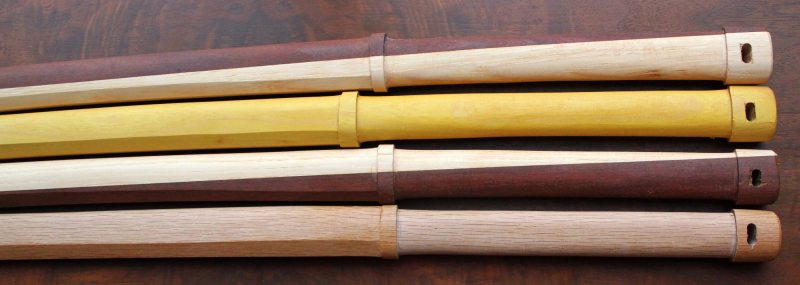
I grabbed a few blanks, including a shiro kashi from the stock and carved out the hilts, ready to be wrapped by proud new owners who want a cool grip. I've also provided a hole in the "fuchi kashira" so the knot can be done properly.
Now, I had to try this myself so I just grabbed a couple of sageo length pieces of braid I had around the place.
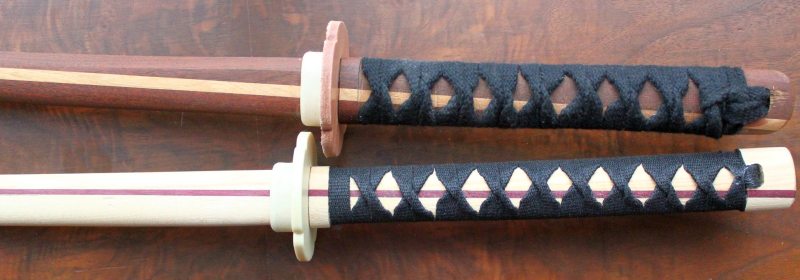
The nylon braid is a bit slippery and probably hard on your hands, but almost the right size, the polypropylene on top is our standard sageo material and is much too thick. In both cases I had to glue the knot because I suck at this stuff and a sageo length is just a few inches too short. On the other hand, I didn't spend more than half an hour on either of them. I'm sure someone taking a bit of time would do a much better job.
The project would benefit from same or some other under-wrap if you don't like the stripes in the hilt. Menuki would also look good. The nylon braid might also benefit from paper stuffing under the wrap on the twists.
If you want to work on a project like this, check out the one of a kind page where the four bokuto above are on sale. Brenda is also trying to chase down some cotton braid that might be suitable for wrapping.
These are actually a lot of fun to work on in the evenings when you're watching the tube, I hope you try one.
We are about to make an order for iaito to Japan, usually we pick up already-made iaito because they ship faster but this time we can afford to wait a little bit. Well actually that's "we can't afford to order right away". If we pre-sell some iaito we can order sooner.
So.
If you have a size, and some customization you'd like done (different colour wrap, fittings etc.) let us know and you can pre-order it. Please note that we will check to see that all parts are available and if not we'll let you know. I don't want to get back into the custom iaito business because it's too much work for the markups we charge, available customization should be fine, if it's not available....
Call this "semi custom" OK? As in: "Hey Kim I'd like a maroon wrap at 2.45 with higo koshirae and bat menuki if available but substitute if necessary please".
That way we can get a price right away, then you can pay and be sure you'll get it as soon as we get the rest of the order. (And we get to order sooner).
Note that we now have two different lines of iaito from Japan, a lesser-cost line and the best line we can get our hands on. The difference in price is considerable so specify which you're interested in. Customization on the higher line will likely be easier than on the "intro" line.
Superior Iaito: http://sdksupplies.com/cat_iaito-top.html (Buttons to buy, photos of what we've got)
Standard Iaito: http://sdksupplies.com/cat_iaito.htm (We've got a 2.4 available and that's it right now, we're looking to order some of these asap).
Oh, and if for some reason a semi-custom order does get delayed, we'll let you know and refund your payment when you want it... the blade will appear eventually but who wants to wait?
It occurs to me that I need to be more active with the selling of stuff..... see the post below this for the reason for that blinding flash of insight. Email link is at the top left of the page.
Bloodwood (finally got some with nice colour)
Honduras Rosewood (up to bokuto lengths) I've made some with this above, it is a stock of wood turning blanks that was sitting in a warehouse for the last 50 years. I've bought as much as I can get my hands on to bokuto length. I can do straightish bokuto, canes, sticks, shoto, tanto and other such sized pieces.
Makassar Ebony Not in my shop but I can get hold of pieces up to jo length. I'll get some on my next buying trip.
Cocobolo Have some nice stock that is up to jo length
Satine I'd love to try some of this wood, I can get it. Light brown colour, heavy wood.
Black Palm Bokuto lengths, I have some 1" square, cane lengths in the shop but I can get bokuto sized pieces. This is a dense black wood with grass-bamboo like stripes... it's a grass. Not for banging but amazing "throw" for swinging. Want to make some bokuto from this stuff.
Tanto Mass Orders I accumulate a lot of wood that is tanto length, if you want dojo sets let me know and we'll put together a good deal for you, I hate burning anything but letter-opener sized scraps but my corners runneth over with short pieces.
One of a kind, already made bokuto are available here: http://sdksupplies.com/cat_bokuto_singles.html
Not that I ever did...
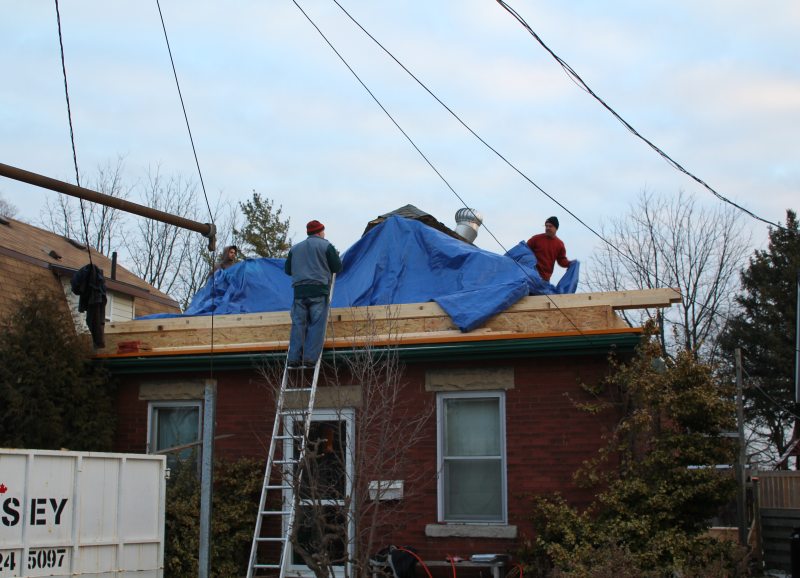
Jan 3: There's Unka Kim up the ladder looking at the half-chopped off roof on our little brick bungalow. The roof was 2x4s and boards. I think the boards were holding up the 2x4s mostly.

Jan 4: You gotta love these new digital cameras, that's ISO 6400 at 1/25 of a second... Streetlight in other words. The deck is on TJI joists, the sides are site-built and the top is a truss system.
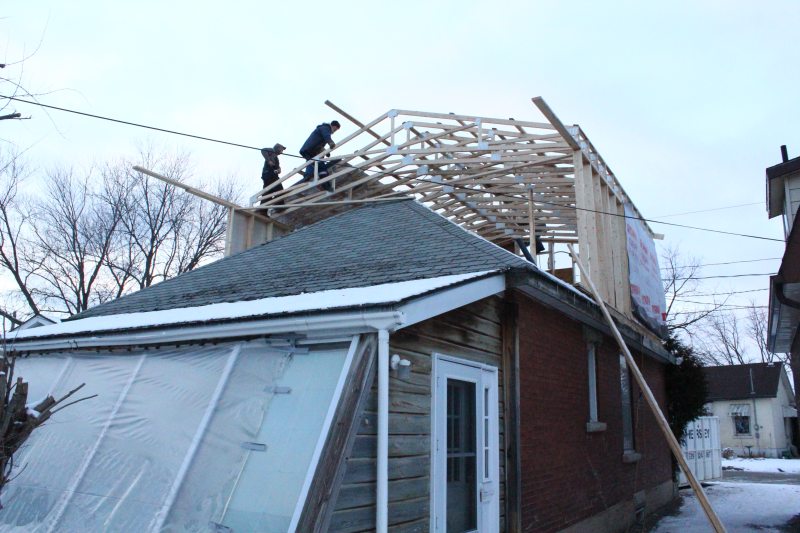
Jan 5: Here's the back end with the wind-wrap going on. There's my poor old sunroom that the Iaido club built those many years ago. The wall under the windows sprang a leak and rotted and the carpenter ants finished the job.

There's the rest of the roof, trusses against the fence. Maybe once the house is all new and shiny Brenda will let me replace my poor old rusty garage (shop) door. Yes that's where the magic happens folks, the wood inside that place is likely worth more than the garage itself.

Jan 6: It started to snow, we're on our second dumpster and the cladding is on the front. It took me about four hours to get used to seeing this shape, mostly because it is almost exactly the shape of our cottage.

Jan 22 after some delays and working on the inside. That's the laundry room on the right and bedrooms on the left. You can see the joist system, they span from one side to the other so, with the insulation there shouldn't be much noise coming through to the first floor.
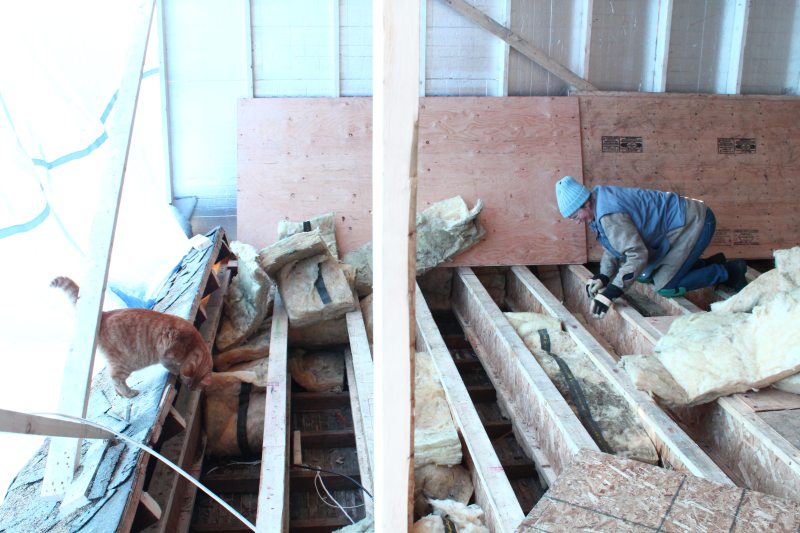
It was -20 C so Brenda is putting the insulation back onto the ceilings for the weekend. There's the cat's first trip to the second floor, he came up the ladder after us to see what was going on, went back down the ladder too. You can see the old ceiling joists below the new ones, a bunch of folks including a couple of the club helped us tear the old paper-wrapped insulation out of the ceiling and vacuum it before putting the newish stuff back in. A dirty job that took me back to my youth when I put that sort of insulation into cottages for the old man, mid-summer, tiny crawl-space attics and short fibered insulation. Around then I decided I'd go to University so of course 40 years later I'm up to my elbows in the same damned stuff.

Jan 25: It finally warmed up enough to get back outside working and the contractor has decided to build over the sunroom instead of tearing it down. Pretty slick actually.

There's the old deck and the shade in the back back yard. That's where half the furniture in the house is living right now... none of it worth stealing so don't bother thinking about it you bad guys out there.
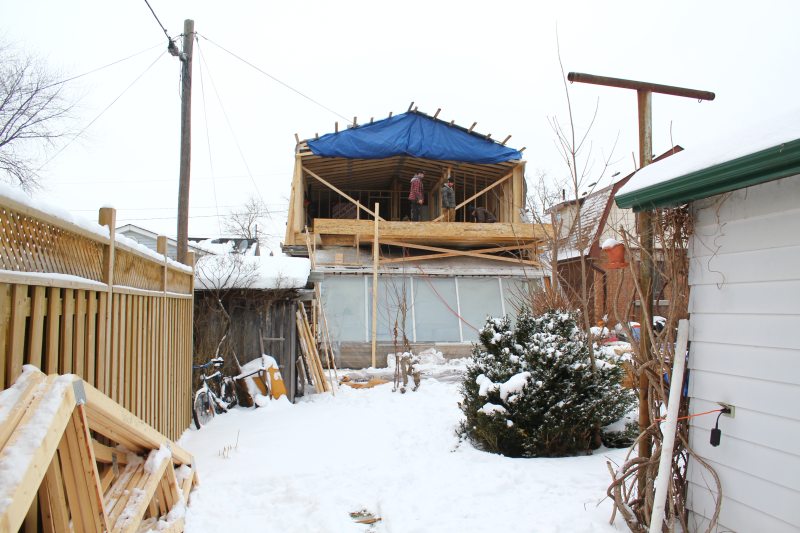
The long view, up beside the garage. The new place is going to be huge. The deck without the shell over it is the master bedroom. That was yesterday and I'll continue this later, at the moment (today) the trusses to the left are now up top. There are so many guys around here today I'm just hiding inside, nothing for me to do to help. Not that I mind.
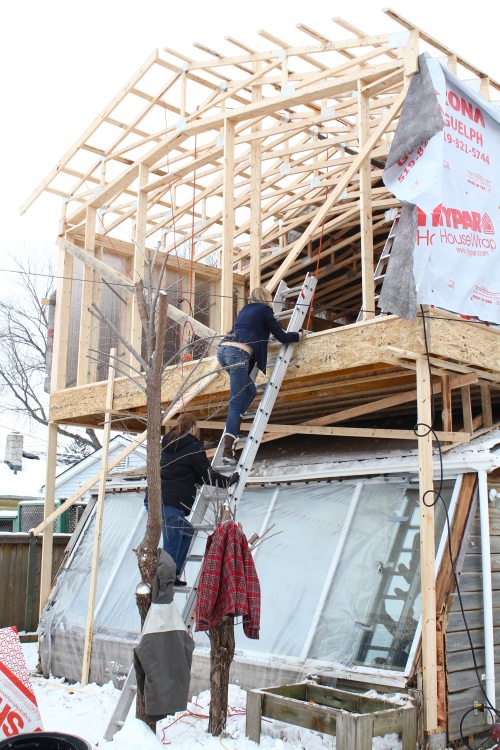
Jan 26: Lauren and Brenda heading up to check things out for the master bedroom.
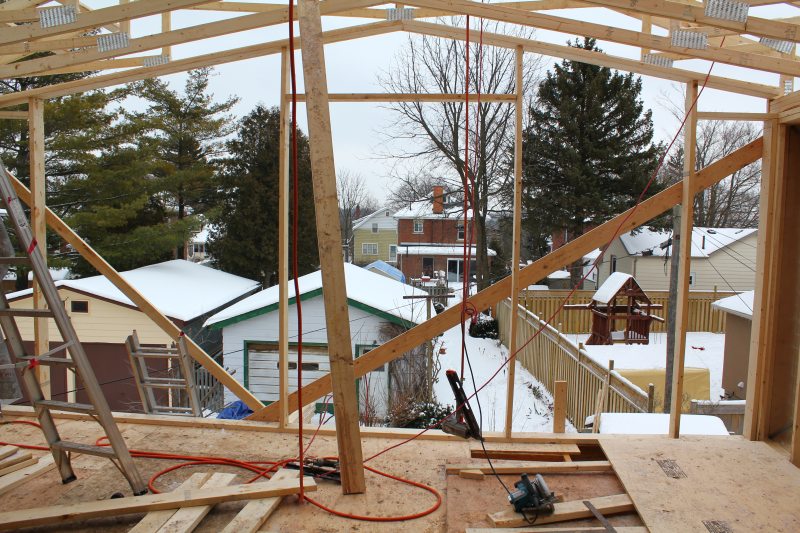
Right about here I started talking about a glass wall just because I hated to see that view disappear.


Jan 29: Another weekend break. As the contractor says "A barn came and ate a brick bungalow" I think the front of our house looks a little surprised but at least it has rosy cheeks. The two little windows up top are at the ceiling of the inside bedrooms and will let light across the ceiling right over all the rooms. There will be one at the back end too. The sunroom is looking smaller and smaller.
Just saw a note on the net that Professor Yamada Shoji has published "Shots in the Dark: Japan, Zen and the West" which apparently is an amplification of his essay "The Myth of Zen in the Art of Archery" http://nirc.nanzan-u.ac.jp/publications/jjrs/pdf/586.pdf
The idea seems to be that Foreign ideas about Japanese culture can influence the ideas Japanese have about their own culture.
Wow what a concept, that Japanese culture could be influenced by anything outside Japan. Radical man.
Of course it is.
We just discovered a heretofore unknown species of hominid in Denisova, the Altai mountains near Mongolia. These seem not to be Neanderthals and not to be Homo Sapiens, but a brand new species.... and yet DNA seems to indicate that this "species" interbred with the H. Sapiens who ended up in New Guinea. This same type of evidence would also indicate that 2% of our DNA comes from interbreeding with Neanderthals. Even different "species" (biologically a species is something that can't interbreed) influence each other across 20,000 years.
It is no shock that modern Japanese budo folks would be influenced by what non-Japanese think about the subject. Our ideas on Karate are influenced by the military who first imported it to the USA after WWII, the old Japanese sword schools were influenced by the State Shinto and ultranationalist ideas of the Japanese military before WWII.
Although we all delight in puncturing the status quo, there are few serious scholars who ever thought that the martial arts were all about Zen.
On the other hand, there are many who started the arts and continue them as a way to meditate that is similar to, and has many of the same effects as zazen. The Zen Monks will say that there is no "Zen of Running" or "Zen of Archery" (I've been at that sermon) but I give those folks as much credit as the budo purists who insist that martial arts is all about Esoteric Buddhism rather than Zen.
It's as much about State Shinto as it is about Shingon finger waving folks, but why are you practicing? Why is it that you spend large amounts of time doing something that hasn't had much of a use for generations, and then only in a country half way around the world?
If Japanese Edo-period culture can influence you, why can't your culture influence modern Japan? Is that really a shocking thought?